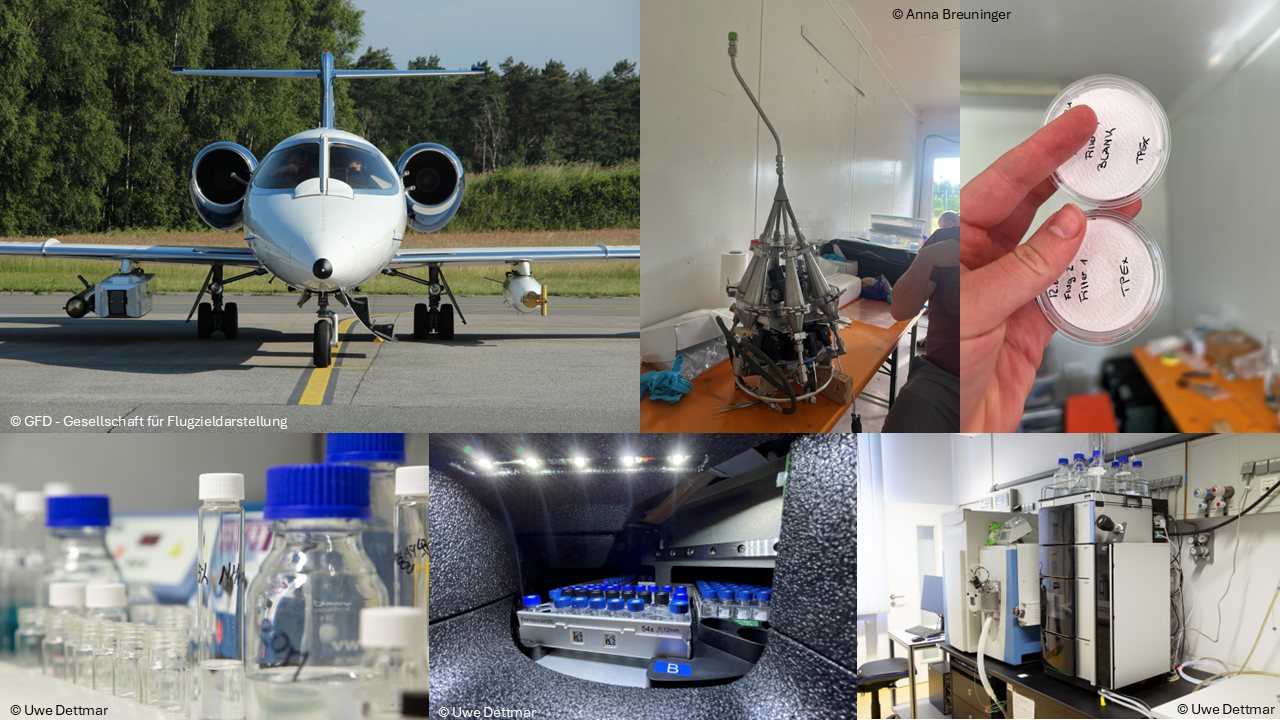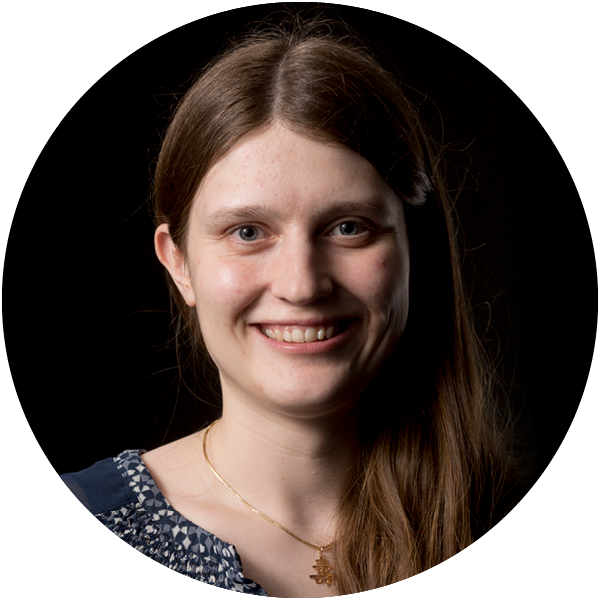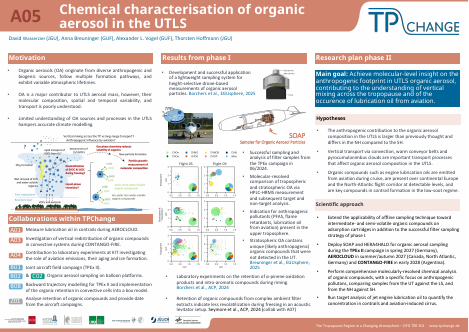
Project A05:
Chemical characterisation of organic aerosol in the UTLS
Brief Summary
Project A05 aims to improve our understanding of the composition of organic aerosols in the upper troposphere and lower stratosphere (UTLS). Key efforts in the years 2027 and 2028 include participation in three aircraft campaigns, that will allow us to sample particles and semi-volatile gases in this pristine and hard-to-reach region of the atmosphere. We aim specifically at identifying how anthropogenic emissions have changed the organic aerosol composition in the UTLS, either through vertical transport processes or directly introduced by aircraft flying over the North-Atlantic. We will resolve the chemical composition by employing state-of-the-art analytical technologies on the airborne samples and resolve the aerosol composition molecule by molecule. This involves high-resolution mass spectrometry in combination with gas and liquid chromatography. Through collaborative work with the other involved groups within TPChange, we have the unique chance to obtain a comprehensive picture on transport, redistribution and fate of aerosol pollution in the UTLS.

The workflow of offline organic aerosol measurements in the UTLS: sampling on filters, liquid extraction, analysis by liquid chromatography and high-resolution mass spectrometry.
Project Poster
Evaluation Poster Phase I in 2025
Members

Prof. Dr. Alexander Vogel
Principal Investigator
Goethe-Universität Frankfurt, Institut für Atmosphäre und Umwelt
vogel[at]iau.uni-frankfurt.de

Prof. Dr. Thorsten Hoffmann
Principal Investigator
Johannes Gutenberg-Universität Mainz, Institut für Anorganische Chemie und Analytische Chemie
hoffmant[at]uni-mainz.de

Anna Breuninger
Doctoral Candidate
Goethe-Universität Frankfurt, Institut für Atmosphäre und Umwelt
breuninger[at]iau.uni-frankfurt.de

David Wasserzier
Doctoral Candidate
Johannes Gutenberg-Universität Mainz, Institut für Anorganische Chemie und Analytische Chemie
dawasser[at]uni-mainz.de

Former Member Phase I:
Christine Borchers
Doctoral Candidate
Johannes Gutenberg-Universität Mainz, Institut für Anorganische Chemie und Analytische Chemie
Publications
Leppla, D., S. Hildmann, N. Zannoni, L. A. Kremper, B. A. Holanda, J. Williams, C. Pöhlker, S. Wolff, M. Sà, M. C. Solci, U. Pöschl, and T. Hoffmann (2026): Comprehensive non-targeted molecular characterization of organic aerosols in the Amazon rainforest. Atmospheric Chemistry and Physics 26 (1), 365–390. doi: 10.5194/acp- 26-365-2026
Borchers, C., L. Moormann, B. Geil, N. Karbach, D. Wasserzier, and T. Hoffmann (2025): Development and use of a lightweight sampling system for height-selective UAV-based measurements of organic aerosol particles. Atmospheric Measurement Techniques 18 (23), 7231–7242. doi: 10.5194/amt-18-7231-2025.
Bozem, H., P. Joppe, Y. Li, N. Emig, A. Afchine, A. Breuninger, J. Curtius, S. Hofmann, S. Ismayil, K. Kandler, D. Kunkel, A. Kutschka, H.-C. Lachnitt, A. Petzold, S. Richter, T. Röschenthaler, C. Rolf, L. Schneider, J. Schneider, A. Vogel, and P. Hoor (2025): The TropoPause Composition TOwed Sensor Shuttle (TPC-TOSS): a new airborne dual platform approach for atmospheric composition measurements at the tropopause. Atmospheric Measurement Techniques 18 (22), 6545–6568. doi: 10.5194/amt-18-6545-2025.
Breuninger, A., P. Joppe, J. Wilsch, C. Schwenk, H. Bozem, N. Emig, L. Merkel, R. Rossberg, T. Keber, A. Kutschka, P. Waleska, S. Hofmann, S. Richter, F. Ungeheuer, K. Dörholt, T. Hoffmann, A. Miltenberger, J. Schneider, P. Hoor, and A. L. Vogel (2025): Organic aerosols mixing across the tropopause and its implication for anthropogenic pollution of the UTLS. Atmospheric Chemistry and Physics 25 (22), 16533–16551. doi: 10.5194/acp-25-16533-2025.
Ma, J., N. Reininger, C. Zhao, D. Döbler, J. Rüdiger, Y. Qiu, F. Ungeheuer, M. Simon, L. D’Angelo, A. Breuninger, J. David, Y. Bai, Y. Li, Y. Xue, L. Li, Y. Wang, S. Hildmann, T. Hoffmann, B. Liu, H. Niu, Z. Wu, and A. L. Vogel (2025): Unveiling a large fraction of hidden organosulfates in ambient organic aerosol. Nature Communications 16 (1), 2041–1723. doi: 10.1038/s41467-025-59420-y
Seymore, J., M. Szakáll, A. Theis, S. K. Mitra, C. Borchers, and T. Hoffmann (2025b): Volume uptake of carbonyls during diffusional ice crystal growth. Atmospheric Chemistry and Physics 25 (23), 18249–18265. doi:10.5194/acp-25-18249-2025
Thoma, M., F. Bachmeier, K. Knauf, J. David, M. Simon, and A. L. Vogel (2025): Seasonal analysis of organic aerosol composition resolves anthropogenic and biogenic sources at a rural background station in central Europe. Environ. Sci.: Atmos. 5, (6), 703–713. doi: 10.1039/D4EA00163J
Borchers, C., J. Seymore, M. Gautam, K. Dörholt, Y. Müller, A. Arndt, L. Gömmer, F. Ungeheuer, M. Szakáll, S. Borrmann, A. Theis, A. L. Vogel, and T. Hoffmann (2024): Retention of α-pinene oxidation products and nitro-aromatic compounds during riming. Atmospheric Chemistry and Physics 24 (24), 13961–13974. doi: 10.5194/acp-24-13961-2024.
Decker, Z. C. J., P. A. Alpert, M. Ammann, J. G. Anet, M. Bauer, T. Cui, L. Durdina, J. Edebeli, M. Gysel-Beer, A. S. H. Prévôt, L. Qi, J. G. Slowik, C. Spirig, S. Tinorua, F. Ungeheuer, A. Vogel, J. Zhang, and B. T. Brem (2024): Emission and Formation of Aircraft Engine Oil Ultrafine Particles. ACS ES&T Air 1, (12), 1662–1672. doi: 10.1021/acsestair.4c00184.
Hildmann, S. and T. Hoffmann (2024): Characterisation of atmospheric organic aerosols with one- and multidimensional liquid chromatography and mass spectrometry: State of the art and future perspectives. TrAC Trends in Analytical Chemistry 175, 117698. doi: https://doi.org/10.1016/j.trac.2024.117698.
Karbach, N., L. Höhler, P. Hoor, H. Bozem, N. Bobrowski, and T. Hoffmann (2024): Preparation of low-concentration H2 test gas mixtures in ambient air for calibration of H2 sensors. Atmospheric Measurement Techniques 17 (13), 4081–4086. doi: 10.5194/amt-17-4081-2024.
Thoma, M., F. Bachmeier, F. L. Gottwald, M. Simon, and A. L. Vogel (2022): Mass spectrometry-based Aerosolomics: a new approach to resolve sources, composition, and partitioning of secondary organic aerosol. Atmospheric Measurement Techniques 15 (23), 7137–7154. doi: https://doi.org/10.5194/amt-15-7137-2022.
Ungeheuer, F., L. Caudillo, F. Ditas, M. Simon, D. van Pinxteren, D. Kılıç, D. Rose, S. Jacobi, A. Kürten, J. Curtius, and A. L. Vogel (2022): Nucleation of jet engine oil vapours is a large source of aviation-related ultrafine particles. Communications Earth & Environment 3 (1), 319. doi: https://doi.org/10.1038/s43247-022-00653-w.

